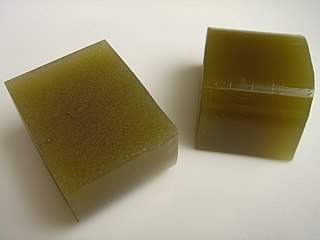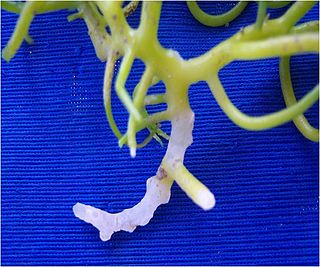
Algae is an informal term for any organisms of a large and diverse group of photosynthetic eukaryotes, which include species from multiple distinct clades. Such organisms range from unicellular microalgae such as Chlorella, Prototheca and the diatoms, to multicellular macroalgae such as the giant kelp, a large brown alga which may grow up to 50 metres (160 ft) in length. Most algae are aquatic organisms and lack many of the distinct cell and tissue types, such as stomata, xylem and phloem that are found in land plants. The largest and most complex marine algae are called seaweeds. In contrast, the most complex freshwater forms are the Charophyta, a division of green algae which includes, for example, Spirogyra and stoneworts. Algae that are carried passively by water are plankton, specifically phytoplankton.

Agar, or agar-agar, is a jelly-like substance consisting of polysaccharides obtained from the cell walls of some species of red algae, primarily from "ogonori" (Gracilaria) and "tengusa" (Gelidiaceae). As found in nature, agar is a mixture of two components, the linear polysaccharide agarose and a heterogeneous mixture of smaller molecules called agaropectin. It forms the supporting structure in the cell walls of certain species of algae and is released on boiling. These algae are known as agarophytes, belonging to the Rhodophyta phylum. The processing of food-grade agar removes the agaropectin, and the commercial product is essentially pure agarose.

Chondrus crispus—commonly called Irish moss or carrageenan moss —is a species of red algae which grows abundantly along the rocky parts of the Atlantic coasts of Europe and North America. In its fresh condition it is soft and cartilaginous, varying in color from a greenish-yellow, through red, to a dark purple or purplish-brown. The principal constituent is a mucilaginous body, made of the polysaccharide carrageenan, which constitutes 55% of its dry weight. The organism also consists of nearly 10% dry weight protein and about 15% dry weight mineral matter, and is rich in iodine and sulfur. When softened in water it has a sea-like odour. Because of the abundant cell wall polysaccharides, it will form a jelly when boiled, containing from 20 to 100 times its weight of water.

Carrageenans or carrageenins are a family of natural linear sulfated polysaccharides. They are extracted from red edible seaweeds. Carrageenans are widely used in the food industry, for their gelling, thickening, and stabilizing properties. Their main application is in dairy and meat products, due to their strong binding to food proteins. Carrageenans have emerged as a promising candidate in tissue engineering and regenerative medicine applications as they resemble animal glycosaminoglycans (GAGs). They are used for tissue engineering, wound coverage, and drug delivery.

Algaculture is a form of aquaculture involving the farming of species of algae.

Mastocarpus stellatus, commonly known as carrageenan moss or false Irish moss, is a species in the Rhodophyceae division, a red algae seaweed division, and the Phyllophoracea family. M. stellatus is closely related to Irish Moss. It grows in the intertidal zone. It is most collected in North Atlantic regions such as Ireland and Scotland, together with Irish moss, dried, and sold for cooking and as the basis for a drink reputed to ward off colds and flu. Marine biologists have completed studies on the medicinal reputation of M. stellatus to discover the full potential of its pharmaceutical benefits. Additionally, marine biologists have conducted research on its potential to serve as an alternative to plastic. The application of M. stellatus in these different industries is correlated with the seaweed's adaptations which developed in response to the environmental stressors present around its location on the rocky intertidal.

Kappaphycus alvarezii, the elkhorn sea moss, is a species of red algae. The elkhorn sea moss varies in size, weight, and age. It is a dark greenish-brown hue and can sometimes be deep purple. The moss is cylindrical in shape throughout the seaweed. Its diameter averages 1.526 mm when dried. Near the base of the seaweed, its average length is from 1 mm to 17 mm and 1 mm to 2 mm in diameter. Firm algae are around 2 m tall, with axes and branches around 1–2 cm in diameter. It used to be believed they reproduced through vegetative fermentation, but recent studies show that they reproduce sexually. They reproduce through vegetative propagation and reproduce sexually. Cross sections of the Elkhorn sea moss have a medulla composed of small thick-walled cells interspaced among large parenchyma cells. This moss is used for various types of foods that humans consume and can also be used to make a jelly-like dessert. This moss is a very good source of minerals and of high commercial interest. It is one of the most important commercial sources of carrageenans, a family of gel-forming, viscosifying polysaccharides. Farming methods affect the character of the carrageenan that can be extracted from the seaweed. It is very fast-growing, known to double its biomass in 15 days.

Gulaman, in Filipino cuisine, is a bar, or powdered form, of dried agar or carrageenan extracted from edible seaweed used to make jelly-like desserts. In common usage, it also usually refers to the refreshment sago't gulaman, sometimes referred to as samalamig, sold at roadside stalls and vendors.

Seaweed, or macroalgae, refers to thousands of species of macroscopic, multicellular, marine algae. The term includes some types of Rhodophyta (red), Phaeophyta (brown) and Chlorophyta (green) macroalgae. Seaweed species such as kelps provide essential nursery habitat for fisheries and other marine species and thus protect food sources; other species, such as planktonic algae, play a vital role in capturing carbon and producing at least 50% of Earth's oxygen.

Edible seaweed, or sea vegetables, are seaweeds that can be eaten and used for culinary purposes. They typically contain high amounts of fiber. They may belong to one of several groups of multicellular algae: the red algae, green algae, and brown algae. Seaweeds are also harvested or cultivated for the extraction of polysaccharides such as alginate, agar and carrageenan, gelatinous substances collectively known as hydrocolloids or phycocolloids. Hydrocolloids have attained commercial significance, especially in food production as food additives. The food industry exploits the gelling, water-retention, emulsifying and other physical properties of these hydrocolloids.

Ice-ice is a disease condition of seaweed. Ice-ice is caused when changes in salinity, ocean temperature and light intensity cause stress to seaweeds, making them produce a "moist organic substance" that attracts bacteria in the water and induces the characteristic "whitening" and hardening of the seaweed's tissues. Bacteria involved include those in the Vibrio-Aeromonas and Cytophaga-Flavobacteria complexes. The bacteria lyse epidermal cells and chloroplasts, turning the seaweed tissue white. The disease is known from seaweeds including Kappaphycus alvarezii and Eucheuma denticulatum, economically important sources of carrageenan. In countries where seaweed is harvested as a crop, ice-ice can wreak havoc on yields. Zamboanga, Philippines, had an outbreak of ice-ice in 2004, and Bali, Indonesia, experienced an outbreak in 2009. A rise in surface sea temperatures of 2–3 degrees Celsius can trigger ice-ice outbreaks.

Seaweed farming or kelp farming is the practice of cultivating and harvesting seaweed. In its simplest form farmers gather from natural beds, while at the other extreme farmers fully control the crop's life cycle.

Kappaphycus is a genus of red algae. Species are distributed in the waters of East Africa, Indonesia, Malaysia, Hainan Island, the Philippines, and Micronesia.
Sea sponge aquaculture is the process of farming sea sponges under controlled conditions. It has been conducted in the world's oceans for centuries using a number of aquaculture techniques. There are many factors such as light, salinity, pH, dissolved oxygen and the accumulation of waste products that influence the growth rate of sponges. The benefits of sea sponge aquaculture are realised as a result of its ease of establishment, minimum infrastructure requirements and the potential to be used as a source of income for populations living in developing countries. Sea sponges are produced on a commercial scale to be used as bath sponges or to extract biologically active compounds which are found in certain sponge species. Techniques such as the rope and mesh bag method are used to culture sponges independently or within an integrated multi-trophic aquaculture system setting. One of the only true sustainable sea sponges cultivated in the world occur in the region of Micronesia, with a number of growing and production methods used to ensure and maintain the continued sustainability of these farmed species.

Eucheuma, commonly known as sea moss or gusô, is a rhodophyte seaweed that may vary in color. Eucheuma species are used in the production of carrageenan, an ingredient for cosmetics, food processing, and industrial manufacturing, as well as a food source for people in the Philippines, Caribbean and parts of Indonesia and Malaysia. Eucheuma cottonii – which grows in the Caribbean and cultivated in the Philippines – is the particular species known as gusô. Other species include Betaphycus gelatinae, Eucheuma denticulatum, and several species of the genus Kappaphycus, including K. alvarezii. Since the mid-1970s, Kappaphycus and Eucheuma have been a major source for the expansion of the carrageenan industry.

Gavino Trono Jr. is a Filipino marine biologist dubbed as the "Father of Kappaphycus farming". He was conferred the rank of National Scientist of the Philippines for contributions to the study of tropical marine phycology, focusing on seaweed biodiversity. He is currently a professor emeritus of the University of the Philippines Marine Science Institute.

Hypnea is a genus of red algae, and a well known carrageenophyte.

Furcellaria is a genus of red algae. It is a monotypic genus, the only species being Furcellaria lumbricalis, which has commercial importance as a raw material for carrageenan production. It is mainly harvested from the waters of Denmark and Canada.

Aquaculture in the Philippines makes up a substantial proportion of the overall output of Philippine fisheries. Aquaculture has a long history in the archipelago, with wild-caught milkfish being farmed in tidally-fed fish ponds for centuries. Modern aquaculture is carried out in freshwater, brackish water, and seawater throughout the country through a variety of methods.
















